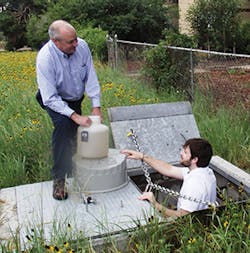It was beer that led Ken MacKenzie, P.E., CFM, to his job as master planning manager for the Urban Drainage and Flood Control District (UDFCD) in Denver, CO. Years ago, he became proficient in home-brewing beer, fascinated by its biological, chemical, and physical processes. In his ongoing efforts for better results, he’d contacted the local water utility for information on the water’s constituents. While his primary interest was in the pH—”a critical factor in making good beer,” he points out—he was amazed by the local water report, which detailed factors he’d never considered: metals, nutrients, hardness, and conductivity. It got him thinking about what was really in his drinking water and where it was sourced and eventually led him to his present-day career.
The UDFCD works with local governments addressing multi-jurisdictional drainage and flood control challenges through flood information, electronic data mapping, flood control facilities, and monitoring stormwater quality. The district has a $25 million annual budget for watershed planning studies and floodplain management activities. A FEMA grant enables the district to act as the agency’s representative in flood mapping studies. UDFCD has a design, construction, and maintenance program implementing improvements that are proposed in master planning studies and then maintains those improvements after they are built. The district partners with local communities on matters too complex to achieve independently, says MacKenzie. A maintenance eligibility program encourages private developers to follow UDFCD design and construction criteria; for those who do, the district maintains the built improvements in perpetuity in an effort to promote regional uniformity.
What He Does Day to Day
MacKenzie manages two senior project engineers and three graduate students in a planning program responsible for watershed planning and flood hazard area delineation studies, stormwater quality research, and maintaining detailed records of regional rainfall and runoff, critical for improving hydraulic structure designs. They also promulgate design criteria and software related to drainage, flood control, and stormwater quality. The program assists Colorado MS4 permittees with compliance issues. MacKenzie also teaches continuing education engineering classes for the nonprofit Urban Watersheds Research Institute, where he serves on the board of directors. He also co-chairs the stormwater management committee for the National Association of Flood & Stormwater Management Agencies, which signed a Memorandum of Understanding with the EPA to work on the national implementation of green infrastructure, helping to define its benefits to stormwater quality and flood damage mitigation.
“The EPA is very concerned with the quality of stormwater runoff—particularly urban runoff,” notes MacKenzie. “There are problems with agricultural runoff, mostly related to nutrients and fertilizers, but with urban runoff, the concentrations of a wider spectrum of pollutants are higher.” He points out that EPA has successfully worked with combined sewer overflow communities in implementing green infrastructure, which in many cases can achieve runoff reduction goals more cost effectively than traditional infrastructure.
What Led Him to This Line of Work
MacKenzie dropped out of the University of Colorado after two years of studying philosophy. He attended trade school and took a job with Continental Airlines in Denver as an airplane mechanic, a job in which he says he excelled. Continental eventually shuttered its Denver operation. MacKenzie turned down a relocation offer and, inspired by his beer brewing, returned to college to study water quality in conjunction with civil engineering, earning a Master’s degree from the University of Colorado. He interned at UDFCD and worked 15 years for his predecessor, Ben Urbonas, who retired in 2008, at which point MacKenzie took over. The stormwater quality research of MacKenzie and his team leads to advances in criteria for design and maintenance and in software to help people design stormwater treatment facilities. The UDFCD criteria manual has been adopted by 32 cities and seven counties in the Colorado Front Range area and also is being used as far away as Vietnam, Brazil, and China.
What He Likes Best About His Work
“I’m really proud of the people I work with—the level of commitment and responsibility and the mutual respect people in my organization have for each other,” says MacKenzie. He enjoys mentoring the grad students, recalling his own experience being mentored when he started with the district.
MacKenzie also appreciates the opportunity to affect positive change: “To see the research we’ve done as an organization that resulted in changes to criteria implemented on a regional basis and know that Colorado’s lakes and streams are healthier today than they would have been had it not been for that work is extremely satisfying.”
His Greatest Challenge
Dealing with communities and individuals who consider stormwater quality as something that they have to do as a regulatory compliance checkbox instead of something they should want to do is a challenge for MacKenzie. “We should all want to implement measures for clean stormwater to the best of our ability instead of the minimum-required level,” he says.
The legal status quo regarding water rights as part of the prior appropriation doctrine in Colorado limits the district’s ability to do what may be best for stormwater treatment, MacKenzie says. The doctrine means water is used in priority order, and most water rights were taken by the mid-1860s, he points out. He is excited about a project involving the High Line Canal, owned by Denver Water. Its intent was to deliver water to irrigation users, of which there are not many left given the region’s urbanization.
MacKenzie says the canal is extremely inefficient in conveying irrigation water, losing 90% of the water put into it along its 66-mile path. “Denver Water would like very much to give the canal to someone else. They approached me with this idea and I quickly realized this could be one of the most unusual stormwater treatment facilities in the world,” he says.
MacKenzie envisions a 66-mile-long rain garden treating stormwater from the entire tributary watershed on the upstream side of the canal and is engaged in a feasibility study to repurpose the canal as a stormwater treatment bioretention facility. The hitch: UDFCD does not have the right to the water that is tributary to the canal. “In order to treat this stormwater, we’re going to have to augment the loss, that being the canal is completely lined with beautiful cottonwood trees,” he says. “No one wants the canal to be shut down; it’s a favorite recreational amenity to all of the communities it crosses. My solution to treat stormwater provides water for all of these trees, which means it can continue to be a beautiful place to go in the middle of the city and feel like you’re out in the country.”
That would entail paying for the water. “It does not sit well with me that we should have to pay for the right to remove pollution from stormwater runoff,” says MacKenzie. “Some of the water will be consumed by the trees, but most of it will infiltrate into the soil where it’s not lost—it’s just going to take longer to get back into the system.”
MacKenzie is working with all of the state’s MS4-permitted communities to lobby for a change to the Colorado constitution that will define stormwater treatment as an activity that has the minimalist adverse impact on water rights. “Even if I detain stormwater from a regional area and let it go within 48 hours, I’m still open to litigation from a downstream water rights holder or from the state engineer curtailing my activities. It’s long overdue that somebody changes the Colorado constitution to allow stormwater treatment to happen without having to pay for the right to treat the stormwater,” he says, adding that he envisions the legislative bill coming into play in the next two years.


